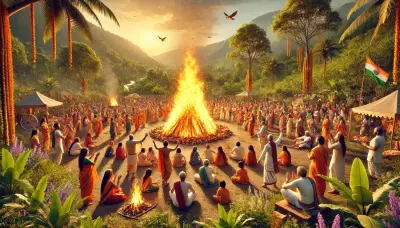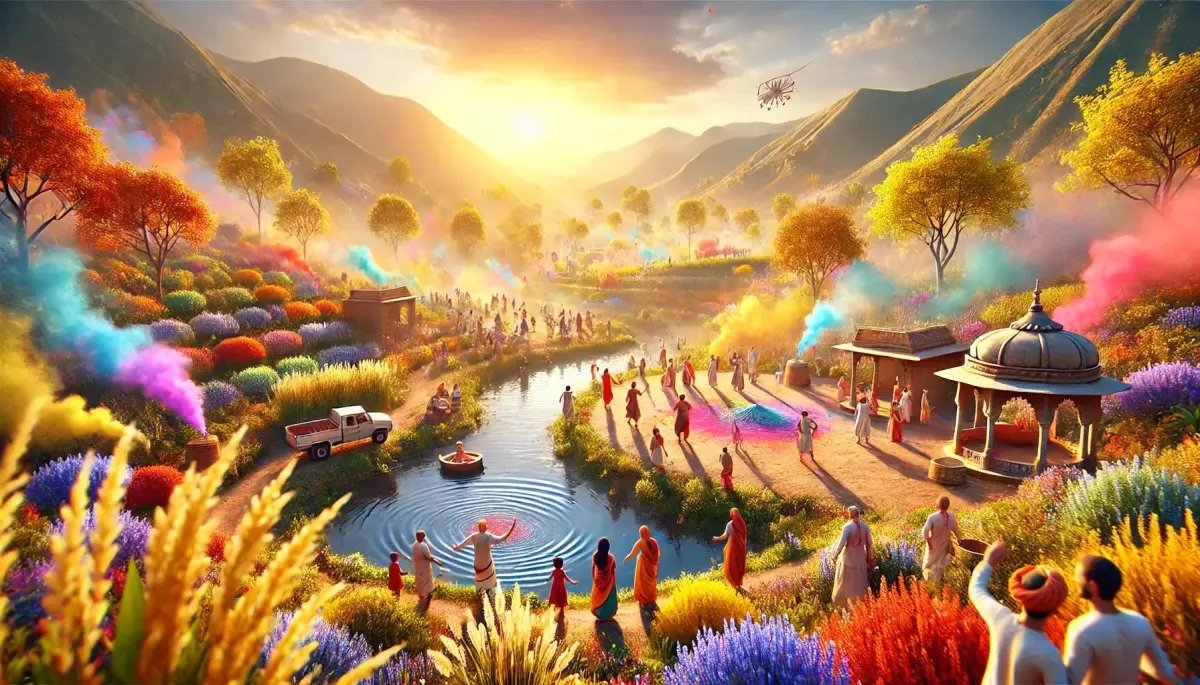Holi is one of the most vibrant and colorful festivals of Indian culture, celebrated annually throughout the country and by Indian communities around the world. Also known as the "Festival of Colors", Holi symbolizes the arrival of spring and the victory of good over evil. During this celebration, people come together to throw colored powders at each other, dance, sing, and share delicious typical dishes. This explosion of colors not only beautifies the streets but also promotes unity and the renewal of bonds among friends and family.
The tradition of Holi dates back to ancient myths and legends, which speak of love, devotion, and the overcoming of adversities. In fact, each color has a special meaning, representing deep emotions and desires. Thus, the festival is not just a visual feast, but a true emotional experience that resonates with people of all ages.
If you have not yet had the opportunity to experience Holi, get ready for an unforgettable celebration that promises to leave marks not only on your skin but also in your heart. Come discover the magic and joy that this festival provides!
History and Meaning of Holi in Indian Culture
Holi, also known as the "Festival of Colors," is one of the most vibrant and significant celebrations in India. Originating from Hindu traditions, the festival marks the arrival of spring and the victory of good over evil. Its history dates back to ancient myths, including the legend of Prahlada and Holika, which symbolizes the importance of devotion and divine protection. During Holi, people remember how Prahlada, a devotee of the god Vishnu, was saved from the flames by divine intervention, while his aunt Holika, who tried to kill him, was consumed by fire. This event represents the triumph of faith and justice.
In addition to its religious significance, Holi also represents renewal and the celebration of life. The festival is a time when social, cultural, and religious differences are temporarily forgotten, promoting unity and harmony among people. During these days, communities come together to share joy and love, transforming the streets into a sea of vibrant colors. This union of all sectors of society is a fundamental aspect that reaffirms the true spirit of Holi.
Full Calendar of Holi until 2050
| Year | Next Date |
|---|---|
| Holi in 2034 | 03/02/2034 |
| Holi in 2042 | 03/02/2042 |
| Holi in 2050 | 03/02/2050 |
| Holi in 2026 | 03/03/2026 |
| Holi in 2031 | 03/06/2031 |
| Holi in 2023 | 03/07/2023 |
| Holi in 2039 | 03/07/2039 |
| Holi in 2047 | 03/07/2047 |
| Holi in 2028 | 03/09/2028 |
| Holi in 2020 | 03/10/2020 |
| Holi in 2036 | 03/10/2036 |
| Holi in 2044 | 03/10/2044 |
| Holi in 2025 | 03/14/2025 |
| Holi in 2033 | 03/14/2033 |
| Holi in 2041 | 03/14/2041 |
| Holi in 2049 | 03/14/2049 |
| Holi in 2030 | 03/17/2030 |
| Holi in 2022 | 03/18/2022 |
| Holi in 2038 | 03/18/2038 |
| Holi in 2046 | 03/18/2046 |
| Holi in 2027 | 03/21/2027 |
| Holi in 2035 | 03/22/2035 |
| Holi in 2043 | 03/22/2043 |
| Holi in 2024 | 03/25/2024 |
| Holi in 2032 | 03/25/2032 |
| Holi in 2040 | 03/25/2040 |
| Holi in 2048 | 03/25/2048 |
| Holi in 2021 | 03/29/2021 |
| Holi in 2029 | 03/29/2029 |
| Holi in 2037 | 03/29/2037 |
| Holi in 2045 | 03/29/2045 |
Traditions and Customs During the Celebration of Holi
The traditions of Holi vary from region to region in India, but some practices are universal. One of the most striking traditions is the use of colored powder, known as "gulal". People gather to throw gulal at each other, creating a spectacle of colors that symbolizes joy and the celebration of life. In addition to gulal, people often bathe in colored water, which adds an element of fun and playfulness to the festival. This interaction not only promotes joy but also symbolizes purification and renewal.
Another important custom is the ritual of lighting a bonfire on the night before Holi, known as "Holika Dahan". This act represents the destruction of evil and the purification of hearts. People gather around the bonfire, singing traditional songs and performing prayers. This moment is an opportunity for reflection and gratitude, reinforcing community and family bonds. At dawn, the celebration begins with the touching of colors, marking the start of a day of festivity and joy.
Colors and Their Meanings in Holi
Colors play a central role in Holi, each carrying its own symbolic meaning. Red, for example, represents love and fertility, while yellow is associated with joy and peace. Green symbolizes nature and renewal, and blue is often linked to the god Krishna. By throwing and spreading these colors, people express their wishes, hopes, and feelings, creating an atmosphere of happiness and positivity.
The choice of colors can also vary depending on local traditions. In some regions, it is common to use colors made from flowers and natural herbs, which are seen as beneficial for health and spirituality. Moreover, the practice of creating color mixtures from natural ingredients reflects the deep connection of Indian culture with nature. This diversity of colors not only beautifies the celebration but also emphasizes the harmony between humans and the environment.
Typical Foods and Drinks Associated with Holi
The typical dishes include a variety of sweets and snacks that are specially prepared for the occasion. Among the most popular are "gujiya", a type of pastry filled with a mixture of grains, sugar, and spices, and "mathri", which is a type of savory biscuit. These dishes are often shared among friends and family, symbolizing unity and the celebration of friendship.
Drinks are also highlighted during Holi, with "bhang" being one of the most traditional. Made from the leaves of the hemp plant, bhang is often mixed with milk, sugar, and spices, creating a refreshing and energizing drink. Additionally, fresh fruit juices and rose water are popular, providing a healthier and tastier alternative. These culinary delights not only satisfy the palate but also strengthen social and cultural bonds among the celebrants.
Events and Festivities in Different Regions of India During Holi
The celebration of Holi is a grand event that varies widely from region to region in India. In cities like Varanasi and Mathura, the festival takes on a spiritual dimension, where thousands of devotees gather to celebrate in temples and sacred places. Varanasi, for example, is famous for its vibrant celebrations on the banks of the Ganges River, where people seek blessings and purification. In Mathura, the birthplace of Krishna, the festivities are filled with dances and music that recall the stories of the deity, creating a mystical and devotion-filled atmosphere.
In the Rajasthan region, Holi celebrations include folk dances and colorful parades, attracting tourists from all over the world. The cities of Jaipur and Udaipur are known for their elaborate festivities, where palaces and streets transform into stages of joy and color. Moreover, celebrations in Punjab are marked by a strong sense of community, with large-scale events that include competitions and traditional games, reinforcing the bonds among participants.
In contrast, in some regions of South India, Holi is celebrated in a more subdued manner, with an emphasis on religious rituals and less on the explosion of colors. Festivals in states like Tamil Nadu and Kerala may include prayers and offerings, emphasizing the spiritual aspect of the celebration. This diversity in Holi celebrations reflects the rich cultural tapestry of India, where different communities and regions bring their own traditions and meanings to the festival, making it a unique and memorable experience for all involved.
Closing
Holi is more than just a simple festival; it is a vibrant celebration of life, love, and unity. Throughout this article, we explored the rich history and profound meanings surrounding this colorful tradition. From the colors that symbolize diversity to the rituals that promote harmony among people, Holi is an invitation for all of us to reflect on the importance of inclusion and joy in our daily lives.
Finally, as we celebrate Holi, we not only honor its traditions but also renew our commitment to peace and solidarity. May we carry a bit of this vibrant energy into our everyday lives, spreading love and positivity wherever we go. So, as we say goodbye, remember: the true essence of Holi lies within each of us. Let’s make life a grand celebration!

